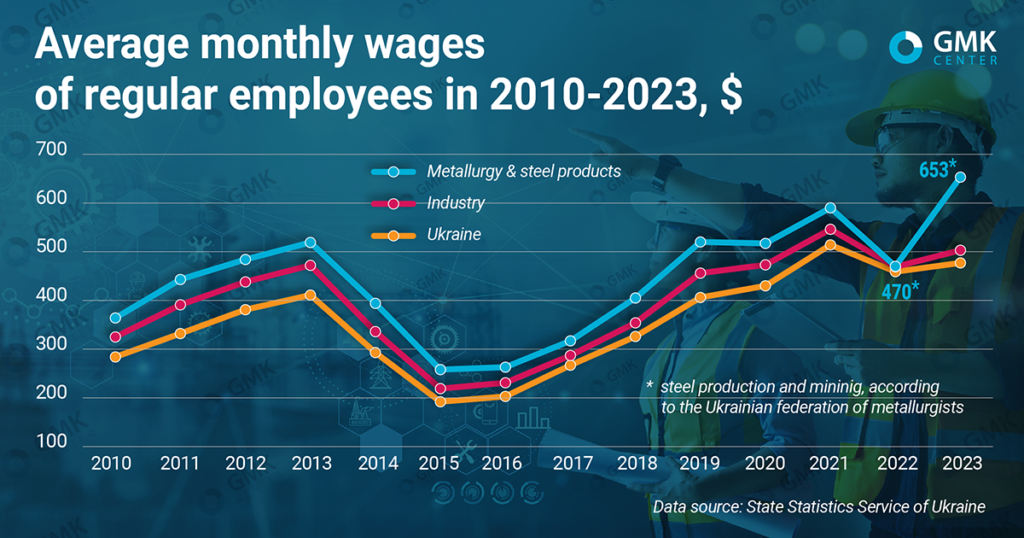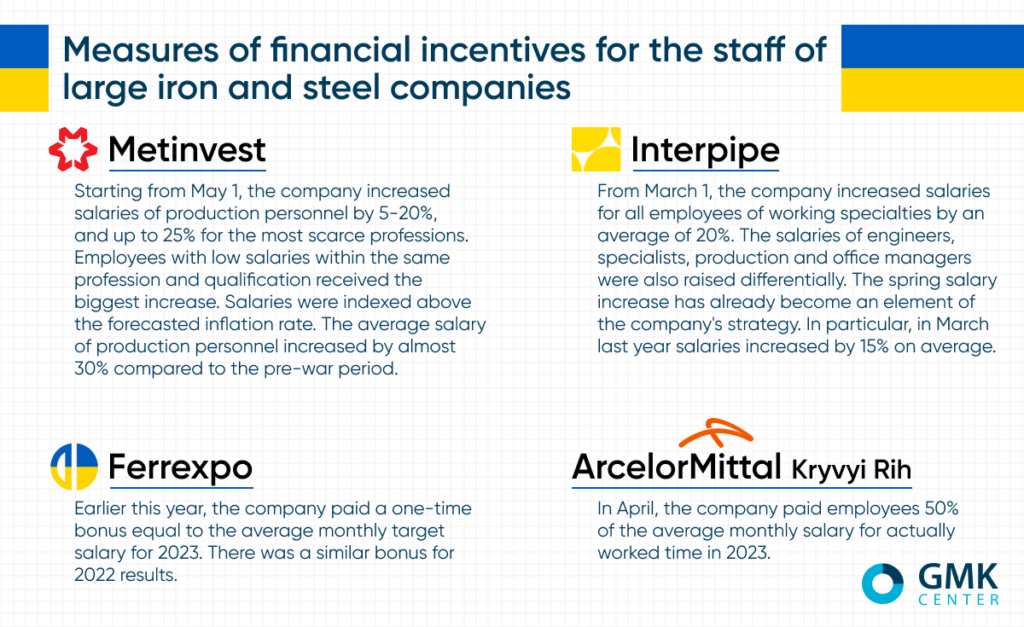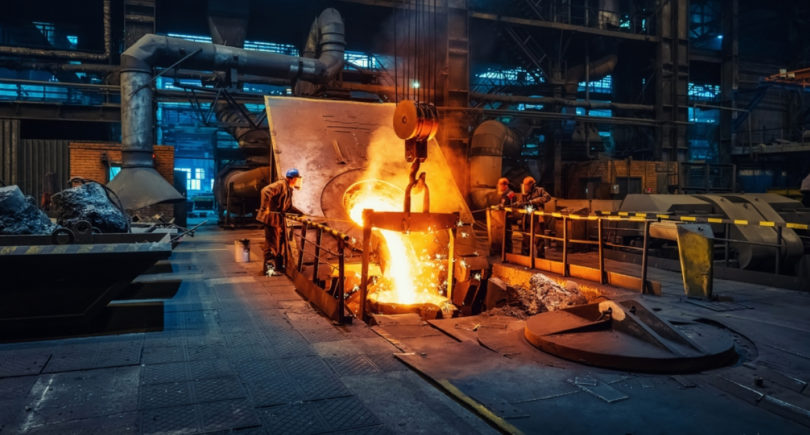
Nominal wages in the industry have already exceeded pre-war levels
In the face of full-scale Russian aggression, Ukrainian iron and steel companies have taken a range of measures to support their employees and preserve their workforce – from financial and psychological support to assistance in relocation and new employment. And this is even despite a 70% drop in production in 2022 and the loss of 40% of all steelmaking capacity.
Even when operating at a loss, companies in the industry did everything to ensure that their staff had stable employment and income – salaries were paid on time, downtime was paid in accordance with legal requirements, and employees were engaged in auxiliary work.
“Our companies are trying to preserve labor collectives by various means, including gradual increase of salaries and other social guarantees. Under unfavorable conditions, when prices for MMC products are very far from historical maximums, and the costs of Ukrainian business on logistics are growing, even a minimal increase in costs is not easy for our enterprises,” says Sergiy Belenkyi, head of the Federation of Metallurgists of Ukraine (FMU).
Salary dynamics
Despite all the difficulties associated with the war, the industry is experiencing positive wage dynamics. According to FMU, the average salary at steel enterprises (the Federation unites 90% of the industry) last year increased by 56.4% – to UAH 23.9 thousand or $653 (at the average annual exchange rate of the NBU). Real inflation-adjusted wages grew 1.5 times. Such high growth occurred due to the low base of comparison in 2022: in December-2022 the average salary in the industry amounted to UAH 15.2 thousand. At that time, many employees were idle due to disruptions in energy supplies after missile attacks on Ukraine’s energy infrastructure.
Already in March of this year, the average salary at FMU enterprises amounted to 24.4 thousand UAH. That is, nominal wages have already exceeded the maximum pre-war level of 21-22 thousand UAH. The average wage in steel sector in dollar equivalent is still below the pre-war level, which is difficult to “catch up” under the conditions of war and the current scale of problems in the industry.
In any case, the level of salaries at Ukrainian iron and steel enterprises has traditionally been significantly higher than the average in Ukraine and the industry. According to State Statistics Service, for 2023 the average salary in Ukraine amounted to UAH 17.4 thousand, in industry – UAH 18.4 thousand.

However, official statistics are still not sufficiently indicative. From the beginning of the war, State Statistics Service not only delayed the release of data, but also gave them in abbreviated form. Above are data on wages in metallurgy and metalware production, which does not take into account the iron ore mining industry and therefore cannot reflect the situation in the entire steel industry. FMU data are more indicative.
Traditionally, in the first half of the year, large steel companies revise salaries and/or take other financial incentives.

Work with personnel
Ukrainian iron and steel companies continue to create conditions for staff training, improvement of knowledge and skills, and requalification. Thus, companies manage to partially cover vacant positions with internal resources, and employees are able to grow within the companies. For example, in Metinvest, retraining is carried out in almost all working professions, in most cases it is carried out directly at the production site. Last year, 13 thousand employees of Metinvest underwent retraining and advanced training.
“Thanks to the corporate center of technical expertise and corporate qualification center, employees and female employees have an opportunity to master new professions or get additional knowledge and skills to improve their qualification or master a related profession in a few months. This helps us to engage our existing staff in new and additional jobs and provide them with opportunities for growth,” Ferrexpo tells about its personnel retraining practice.
Companies in the industry are actively working on attracting young personnel. For example, ArcelorMittal Kryvyi Rih is implementing a number of projects to attract and retain young people at the enterprise, which covered more than 20 thousand students in 2023. These projects included career guidance, career and informal activities, online internships and paid internships for students. Other Ukrainian steel companies are implementing similar projects.
Also, companies in the industry are trying to partially solve the problem of staff shortage with the help of external recruitment.
“Since the beginning of 2024, the company has opened external recruitment for most production professions, for all ages, for women and men. The company has opened more than 1,000 vacancies in various profiles,” ArcelorMittal Kryvyi Rih says.
Work with veterans has become a new direction for personnel work. According to Sergey Belenky, all enterprises of the industry actively implement various rehabilitation programs for demobilized veterans, provide them with psychosocial support, help with treatment or prosthetics.
“We are creating an inclusive ecosystem for integrating veterans into full life and work. Psychosocial rehabilitation and supplemental medical exams are among the main areas of focus. As well as re-entry, retention and adaptation programs. These include requalification, preferential admission to Metinvest Polytechnic. We also teach the team how to accept veterans, and managers how to prevent conflicts in the team. We adopt the US experience in working with war veterans and develop our own practices,” says Tatyana Petruk, Director for Sustainable Development and HR Engagement at Metinvest.
Another relevant type of support for employees in war conditions is assistance in overcoming the consequences of shelling. For example, Interpipe, at its own expense, restores housing and cars of employees who suffered from enemy shelling in Nikopol.
Staff shortage
Under the conditions of the war, the number of employees at steel enterprises was greatly reduced. According to FMU data, in the first year of full-scale hostilities the average number of full-time employees at the enterprises of the association decreased from 126,000 to 80,000 people. Last year, this number fell further to 71.1 thousand people at the end of the period.
Ukrainian steel enterprises, as well as all sectors of the Ukrainian economy, are experiencing a shortage of personnel. The number of open vacancies at the largest companies is in the thousands.
“Currently, there are about 4,000 vacancies in the company. Among the reasons for the shortage are labor migration, mobilization, and people leaving for safer regions and abroad. To overcome the shortage, we are retraining employees so that in addition to their main profession, they get an additional profession they could work in,” says Tatyana Petruk.
The shortage of personnel concerns all working specialties, although depending on the specifics of production, the list of shortage specialties for individual companies will be different. For example, Ferrexpo lacks drivers, electric and gas welders, fitters and repairmen. In its turn, Metinvest lacks people in the following positions: blast furnace mining engineer, coke machine operator, tunneling machine operator, slagging machine operator, caster operator, etc. The key factor that predetermines the shortage of specialties for certain companies is the lack of skilled workers.
The key factor that predetermines the shortage of personnel is mobilization. In total, more than 15% of the total number of employees or about 20 thousand people have already been mobilized at the enterprises of the industry.
“This is a serious challenge for business, as not all existing vacancies can be filled now, especially when it comes to qualified workers and official employment with submission of all information on persons liable for military service to the TCC,” says Sergey Belenkiy.
Although companies in the industry have the right to reserve 50% of employees, this does not fully solve the staffing problems of the plants due to the specifics of technological processes (availability of highly specialized knowledge and experience). Therefore, the enterprises have intensified the hiring of women for positions (crane and conveyor operators, working with equipment, quality control, etc.) where they can replace men.
Migration also has a negative impact on the work of enterprises. Some specialists moved to other regions or abroad at the beginning of the war. Many of them are in no hurry to return, while other employees are leaving unsafe regions where the factories are mainly located.
The problem of staff shortage cannot be solved only by the efforts of the enterprises of the industry. It requires a change in the reservation system. If this problem is not solved, it may become a significant limitation in realization of the plans to increase production, which the enterprises of the industry have set for themselves for the current year. Already now, the shortage of personnel at some enterprises of Metinvest limits the possibility of reaching even 50-60% of the pre-war production.
In the conditions of potential production growth and stable operation of the sea corridor, the problem of shortage of qualified personnel and trained staff is acute for all enterprises of the industry. Iron and steel companies have always been reliable and systematic employers in Ukraine, which operate exclusively in the legal field. Enterprises raise salaries, pay bonuses, invest in training programs and go to all possible steps to solve the problems of personnel shortage, but without active assistance of the state, including in the issues of reservation, potential production growth may be significantly limited.





